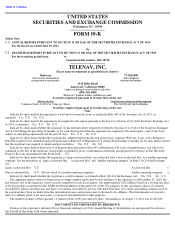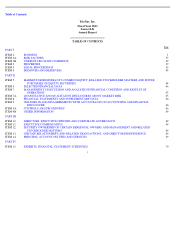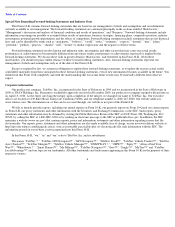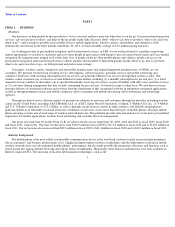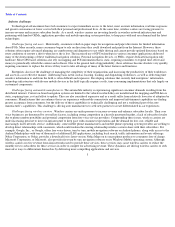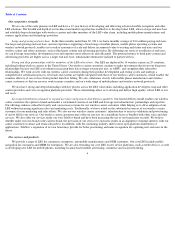TeleNav 2011 Annual Report Download - page 6
Download and view the complete annual report
Please find page 6 of the 2011 TeleNav annual report below. You can navigate through the pages in the report by either clicking on the pages listed below, or by using the keyword search tool below to find specific information within the annual report.
Table of Contents
satellite based Global Positioning System, or GPS, in mobile phones has allowed location data to be used to enhance and expand the services that
can be delivered to mobile phone users and contributed to the emergence of the LBS market.
The LBS market consists of advanced mobile Internet and data applications that leverage location information to provide mobile phone
users with location specific and personalized features and functions. LBS that incorporate location information include turn by turn navigation,
route planning, real time traffic alerts and points of interest, or POI, searches. Beyond these navigation specific services, new mobile LBS, such
as location based advertising, commerce and social networking, have emerged. Heightened consumer awareness of the scope and benefits of
these services are leading to increased demand. These dynamics result, in part, from the availability of advanced GPS enabled mobile phones
and wireless networks as well as wireless carriers’ strong marketing efforts as they seek to increase revenue from data-centric applications, such
as LBS.
Advanced, GPS enabled mobile phones and wireless networks are proliferating . In an effort to remain competitive, mobile phone
manufacturers and wireless carriers are rapidly introducing mobile phones with enhanced features and functions, including GPS. Mobile phones
that incorporate GPS technology are typically capable of supporting advanced mobile phone operating systems and rich data applications
because of other enhancements, such as faster processors, increased memory and larger high resolution screens. Wireless carriers continue to
invest hundreds of billions of dollars deploying 3G and 4G wireless networks worldwide. In combination, these advancements and investments
have changed the way consumers access and interact with Internet based content and services, effectively bringing the richness of the PC based
Internet experience to the mobile phone and enabling the emergence of LBS.
The LBS market offers multiple opportunities for expansion . The enhanced convenience and utility associated with LBS is driving rapid
adoption and growth of the LBS market. For example, mobile navigation, the most popular LBS application today, makes it easier for consumers
to find their way, including driving from one location to another. LBS are not limited to mobile phone based navigation services. LBS enable
consumers to enjoy benefits of an enhanced mobile Internet experience, such as location based advertising, commerce and social networking on
their mobile phones and on other mobile devices. LBS also enables consumers to enjoy an enriched navigation experience in their cars.
Similarly, services such as mobile resource management, or MRM, enable enterprises to leverage the benefits of LBS to more effectively and
efficiently manage their mobile resources.
In response to consumer demand for affordable and easy to use LBS, LBS providers are developing and introducing new applications that
integrate location information in innovative ways. For example, a consumer can use a mobile phone almost anytime and anywhere to help them
quickly decide where to go, how to get there, what to do, and even when to go. As LBS applications increasingly incorporate consumers’
locations and preferences, targeted mobile advertising and commerce will become more compelling and valuable to advertisers and marketers.
In a similar response to consumer demand, automobile manufacturers are introducing affordable navigation units as a central component of
on-board entertainment and information systems. These integrated units extend beyond traditional navigation units by combining audio and
voice capabilities with wireless network connectivity to deliver real time LBS, such as traffic, weather information and other connected data.
Enterprises are seeking solutions that enable them to cost effectively and efficiently manage their mobile resources, as well as their
company data, communications and work flow. Historically, these solutions required the deployment of costly applications and hardware,
primarily limiting the use of these solutions to large enterprises. The development and widespread availability of LBS provides enterprises of all
sizes with a viable alternative, MRM. Enterprise grade LBS solutions can help increase the adoption of mobile business applications. MRM
solutions give business customers visibility over their mobile assets while enabling the movement of real time information like work orders and
proof of service processes.
2


